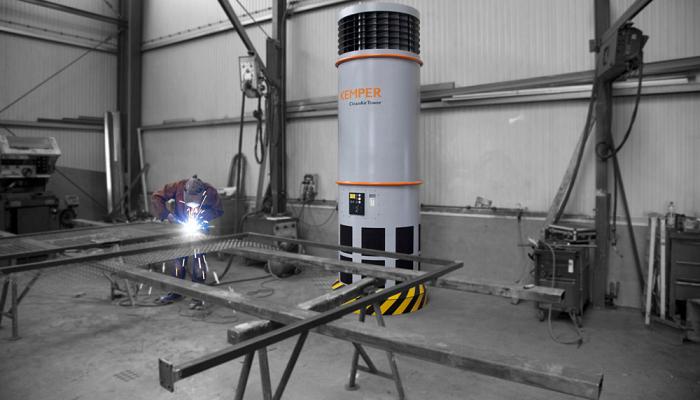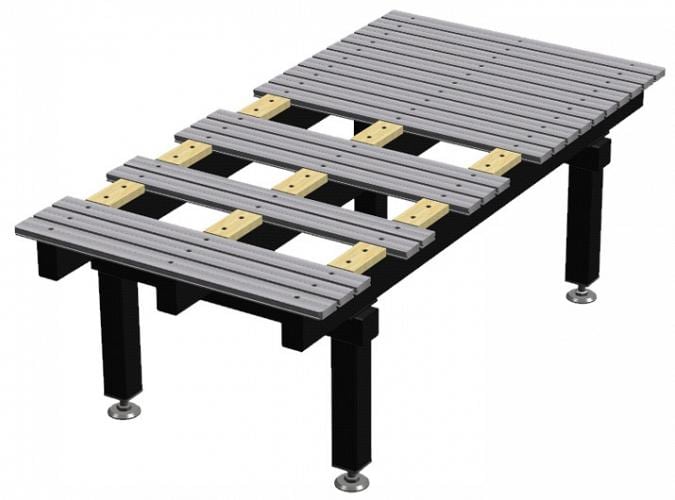WWW.THEFABRICATOR.COM MARCH 2016
MARCH 14, 2016 BY: BENJAMIN HOWELL
Is there room for improvement in your welding operation? Choosing the right ventilation system along with flexible worktables can go a long way toward optimizing your welding process

The best way to optimize any welding process is to use up-to-date, well-designed equipment in a safe, properly ventilated environment. Not only does this enable you to work accurately and cleanly, but it also helps you speed up the production process and ultimately reap cost benefits as well.
Of course, the tools and equipment you choose must meet the requirements of the welding job to be done. The ventilation system you select is determined, to some extent, by the location in which you are working.
When working in a welding workshop or industrial warehouse, the best option is to use a system that delivers full-room ventilation. In addition, modular welding tables that can be adjusted are ideal for most workshop environments, particularly those that accommodate a full range of welding tasks.
Welding Workshop Ventilation
Health and safety are vital issues for welders who, by the very nature of their jobs, face daily health risks from exposure to fumes, smoke, and welding dust. Protective safety gear and clothing are essential, but it isn’t enough. Effective ventilation is paramount, because bad ventilation contributes to polluted air, employee illness, and decreased productivity.
The Occupational Safety & Health Administration (OSHA) has minimum health and safety regulations that relate specifically to ventilation and protection in welding, cutting, and heating. Mechanical ventilation must meet these requirements.
Specifically, the regulations state that mechanical ventilation must consist either of a local exhaust system or a general mechanical ventilation system. The standard states that:
- General mechanical ventilation should have sufficient capacity and be arranged so that it can produce the necessary air changes to ensure that welding fumes and smoke are maintained within safe limits.
- Local exhaust ventilation should incorporate hoods that are freely movable so that the welder can place it very close to the workpiece to get rid of fumes and smoke at the source.
But both have their challenges.
For example, even when exhaust systems are in place, pollution concentration levels can exceed OSHA’s exposure limits, exposing all employees in the building to poor air quality. Welding creates smoke, fumes, and heat. Warm, polluted air rises to the ceiling; as it cools and then sinks, it distributes contaminants, negatively affecting workers on the production floor.
When the traditional push-pull ventilation system is used, the inevitable air turbulence it causes (however slight) results in some pollutants getting into what should be clean air. This type of system relies on pipes that push clean air into the workshop and pull the contaminated air out. Essentially a duct system, it works reasonably well where dust and smoke levels are quite low, but it certainly isn’t foolproof.
Additionally, this is a minimum OSHA specification. Ideally, a local exhaust system should be used in conjunction with a good, general mechanical system for maximum protection. In any case, when local extraction doesn’t work adequately, or at all, good general mechanical ventilation is the answer.

Full-room Ventilation
The best system for ensuring that the air in the welding workshop really is clean and pure is a device that works according to the principles of displacement ventilation, such as a freestanding air tower (Figure 1) that takes advantage of the natural convection cycle.
These energy-saving, general indoor ventilation systems are designed to release fresh air throughout an entire production facility. Quick to set up, easy to move, and self-cleaning, they use source-capture fume-extraction technology that is fully OSHA-compliant.
A clean-air tower works by pulling warm, contaminated air into its filter system through a 360-degree intake at the top of the tower. It then releases cool, clean air from the bottom of the tower to ensure welders are able to breathe fresh air all the time. The polluted air is filtered through an internal filter cartridge, and dust particles are captured in a container for easy removal and contamination-free disposal.
Thermic flow is fully supported without creating any air turbulence, so it’s virtually impossible for dust and gases to pollute the purified air.
Adjustable Welding Tables
You have many choices when it comes to welding tables, including those that are partially covered, movable, have steel support surfaces, and can incorporate their own tool racks. But for anyone working with mild steel and stainless steel, a 3-D welding table with a T-slot system is ideal (Figure 2). Modular, these adjustable designs are able to hold accessories and 3-D components for most welding tasks.
A quality 3-D welding table with a T-slot system allows the welder to access all sides of the workpiece, which increases overall efficiency and improves productivity. The size of the table can be changed, and the slats opened and adjusted to accommodate accessories required for the job. Additionally, the table slats can be adjusted at any time during the welding process.
To further speed up the process and make it even more cost-effective, an adjustable 3-D welding table can be used with a 3-D clamping system, which eliminates the need for the welder to move or change position to access the workpiece.
With the right ventilation and fixtures, you can optimize your welding process and work quickly and cost-efficiently.

